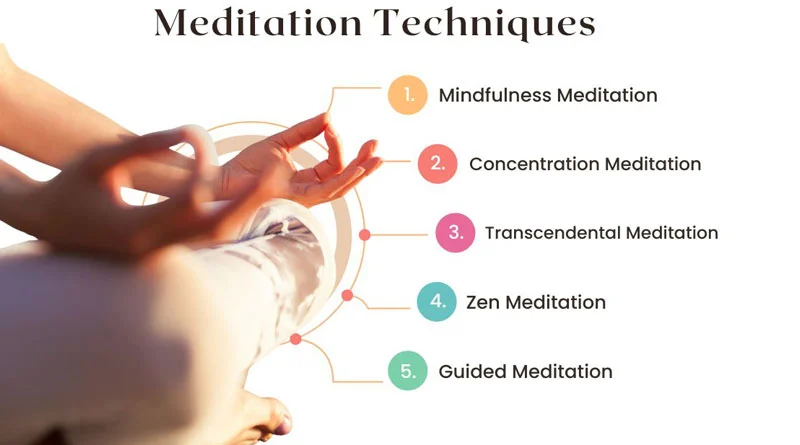
Meditation Techniques
Many people view meditation as a powerful tool for finding inner peace, awareness, and spiritual growth. Meditation has deep roots in ancient traditions. Modern science now supports its benefits. It provides techniques to quiet the mind, calm the body, and help you feel more present.
Many people often link meditation to Eastern spiritual systems like Buddhism and Hinduism. However, it has crossed cultural boundaries. Now, psychologists, healthcare professionals, and people use it in psychology, healthcare, and daily life. Understanding various meditation techniques allows practitioners to choose a method that suits their temperament, goals, and lifestyle.
Historical Background of Meditation Techniques
The origins of meditation date back thousands of years. Scholars find the earliest written records in Hindu texts called the Vedas. Scholars wrote these texts around 1500 BCE. They focus on practices of contemplation and concentration that are important for spiritual life.
In ancient China, Taoist meditation began. It focused on being in harmony with nature and growing life energy (qi). Buddhism, founded by Siddhartha Gautama in the 5th century BCE, made meditation a cornerstone of enlightenment, emphasizing mindfulness (sati) and insight (vipassanā).
Meditation also appears in Western traditions. Early Christian monks practiced contemplative prayer, known as hesychasm, which emphasized silence and the repetition of sacred words. Similarly, in Islamic Sufism, meditation took the form of dhikr, the remembrance of God through rhythmic chanting.
As globalization and modern psychology grew, meditation became more secular. This change led to practices like mindfulness-based stress reduction (MBSR) and other therapy methods.
Core Principles of Meditation Techniques
While there are many styles of meditation, they share several common principles. First, meditation helps with attention control.
It trains the mind to focus on something specific, like the breath, a sound, or a feeling in the body. Second, it requires awareness—observing one’s thoughts and emotions without judgment. Meditation helps you stay present. It helps you maintain your focus on the current moment instead of losing yourself in the past or future.
The ultimate goal of meditation varies among traditions. In spiritual contexts, it may seek enlightenment or a connection with the divine. In psychological contexts, it aims for emotional balance, mental clarity, and less stress. Whatever the goal, meditation begins with practice and discipline—the cultivation of stillness in a restless world.
Major Types of Meditation Techniques
You can broadly categorize meditation practice techniques into concentration-based and mindfulness-based practices, though many blend both approaches. Below are 9 form of Meditation widely practiced methods, each offering unique paths to inner stillness.
1. Mindfulness Meditation
Mindfulness meditation Techniques, rooted in Buddhist vipassanā practice, emphasizes non-judgmental awareness of the present moment. Practitioners observe sensations, thoughts, and emotions as they arise, allowing them to pass without attachment. The breath often serves as an anchor to maintain focus.
A typical mindfulness session begins with sitting comfortably, focusing on breathing, and noticing when the mind wanders. Instead of reacting to distractions, the meditator gently returns to the breath. Over time, this develops greater clarity and emotional resilience.
Mindfulness is now a key part of modern therapy. This includes methods like Mindfulness-Based Stress Reduction (MBSR) and Mindfulness-Based Cognitive Therapy (MBCT). Research shows that practicing mindfulness regularly can lower anxiety, depression, and chronic pain. It also helps improve attention and self-control.
2. Concentration Meditation Techniques
Concentration or samatha meditation trains the mind to focus on a single point of attention. This might be the breath, a candle flame, a mantra, or even a visual symbol. The goal is to stabilize the mind, reducing mental chatter and cultivating tranquility.
When distractions arise, the meditator acknowledges them and returns to the chosen object. Over time, sustained concentration leads to states of deep absorption known as jhana in Buddhist tradition. This technique enhances cognitive focus and can prepare the mind for deeper insight meditation.
3. Loving-Kindness Meditation (Metta Bhavana)
Originating in Theravāda Buddhism, metta bhavana cultivates feelings of compassion, love, and goodwill toward oneself and others. Practitioners silently repeat phrases such as “May I be happy.
May I be healthy. May I be safe.” Gradually, they extend these wishes to friends, strangers, and even enemies.
This meditation softens emotional boundaries and reduces negative emotions such as anger or resentment. Scientific studies indicate that loving-kindness meditation increases positive affect, empathy, and social connectedness. It’s particularly beneficial for those struggling with self-criticism or interpersonal conflict.
4. Transcendental Meditation Techniques (TM)
Transcendental Meditation became popular in the 1950s thanks to Maharishi Mahesh Yogi. It involves silently repeating a personal mantra. You do this for 15 to 20 minutes, twice a day.
Unlike concentration techniques, TM does not require intense focus. Instead, the repetition of the mantra helps the mind settle into a state of restful alertness, transcending thought.
Advocates claim TM reduces stress, lowers blood pressure, and enhances creativity. Scientific studies, though mixed, generally support its benefits for cardiovascular health and relaxation. TM’s simplicity and non-religious presentation have contributed to its global popularity.
5. Body Scan Meditation Techniques
A body scan means focusing on different parts of the body one at a time. You notice feelings like tension, warmth, or tingling. A form of mindfulness often practiced lying down serves as a central component of MBSR.
The technique promotes embodiment—awareness of the physical self—and helps release muscular tension. Many people find it effective for insomnia or chronic pain. It also fosters a compassionate relationship with the body, counteracting the tendency to live “in the head.”
6. Zen Meditation (Zazen)
Zen meditation, or zazen, comes from the Japanese Zen Buddhist tradition. Practitioners usually sit in the lotus or half-lotus position. They focus on their breath or on “just sitting” (shikantaza). They observe their thoughts as they come and go.
Zazen emphasizes posture, breathing, and direct experience. The goal is not to control the mind but to recognize the inherent emptiness of thoughts and phenomena. This practice helps us understand existence better. It often includes koans, which are tricky questions that challenge our usual ways of thinking.
7. Guided Meditation
Guided visualization uses mental imagery to evoke calm or achieve specific goals. A teacher or recording can guide the practitioner through beautiful nature scenes or imagined healing experiences. Athletes and performers often use visualization to enhance confidence and focus.
In spiritual contexts, visualization may involve imagining deities, symbols, or light energy. The practice engages the imagination, linking mind and body through sensory awareness. It can be particularly effective for relaxation and goal manifestation.
8. Movement-Based Meditation Techniques
Not all meditation requires stillness. Practices such as Tai Chi, Qigong, and Walking Meditation integrate gentle movement with mindful awareness. Perform each movement slowly and deliberately, synchronizing it with the breath.
These practices are ideal for those who find seated meditation difficult. They cultivate balance, coordination, and energy flow while grounding the mind in the present. Yoga, though primarily a physical discipline, also functions as moving meditation when performed with conscious awareness.
9. Mantra Meditation Techniques
Mantra meditation is an old practice. It involves repeating a word, phrase, or sound. This helps focus the mind and create inner peace.
The term mantra originates from Sanskrit, meaning “instrument of the mind.” By continually repeating a mantra—either silently or aloud—practitioners channel mental energy toward stillness and heightened awareness.
Many spiritual traditions include this form of meditation. In Hinduism, practitioners use mantras such as Om or So Hum to connect with universal consciousness. In Buddhism, mantras like Om Mani Padme Hum invoke compassion and enlightenment. In more modern adaptations, Transcendental Meditation popularized the use of personalized mantras as a secular relaxation technique.
Wrong Ways to Meditation Techniques
- Expecting instant results
- Meditation is a gradual process; expecting immediate peace or enlightenment leads to frustration.
- Trying to stop thoughts completely
- The goal isn’t to force the mind to be blank but to observe thoughts without attachment.
- Being overly rigid or serious
- Meditation should be relaxed and natural, not forced or tense.
- Judging your meditation sessions
- Thinking “I’m bad at this” or comparing your experience to others hinders progress.
- Meditating only when stressed
- Treating meditation as a quick fix instead of a regular practice reduces its long-term benefits.
- Ignoring posture and comfort
- Sitting awkwardly or straining your body can cause discomfort and distract you from mindfulness.
- Multitasking while meditating
- Trying to check your phone, listen to music, or think about tasks defeats the purpose of focused awareness.
- Holding unrealistic spiritual goals
- Seeking mystical experiences or “special powers” distracts from the true aim of presence and self-awareness.
- Skipping breathing awareness
- Breath is a natural anchor; ignoring it often leads to a restless or unfocused mind.
- Being inconsistent
- Sporadic practice prevents the formation of habit and limits the cumulative effects of meditation.
- Using meditation to escape emotions
- Meditation is about facing thoughts and feelings with compassion, not avoiding them.
- Comparing progress
- Each person’s meditation journey is unique—comparison creates unnecessary pressure.
Scientific Perspectives on Meditation
In recent decades, neuroscience and psychology have validated many of meditation’s traditional claims. Brain imaging studies reveal that regular meditation alters the structure and function of several key regions.
The prefrontal cortex helps with attention and decision-making. It shows increased thickness. The amygdala, which handles fear and stress, tends to shrink.
Meditation enhances neuroplasticity, the brain’s ability to form new connections, supporting emotional regulation and cognitive flexibility. Physiologically, it reduces cortisol levels, lowers heart rate, and improves immune function. Psychologically, it enhances self-awareness, resilience, and compassion.
These findings have led to the integration of meditation into clinical and educational settings. Hospitals use mindfulness to help patients with pain and illness. Schools use meditation to help students focus and feel better. The scientific validation of meditation underscores its relevance beyond religious or cultural contexts.
Challenges and Misconceptions
Despite its benefits, meditation is not always easy. Beginners often encounter restlessness, boredom, or frustration when they realize how active the mind truly is. Some expect instant results or mystical experiences, but meditation’s rewards come gradually with patience and consistency.
Another misconception is that meditation requires suppressing thoughts. In truth, the goal is awareness, not control. Observing thoughts without attachment naturally quiets the mind.
It’s important to know that meditation is not a replacement for professional therapy. However, it can be a helpful addition.
Practical Tips for Beginners
- Start small: Begin with 5–10 minutes daily and gradually extend the duration.
- Choose a method: Experiment with techniques to find one that resonates.
- Create a space: Designate a quiet area free from distractions.
- Be consistent: Practice at the same time each day to build habit.
- Maintain a gentle attitude: When the mind wanders, return to the focus with kindness.
- Seek guidance: Teachers, books, or apps can provide structure and support.
With regular practice, meditation changes from a technique to a way of living. It becomes part of daily activities like walking, eating, or listening.
Conclusion
Meditation Techniques, in its many forms, offers a timeless path to self-discovery and peace. Meditation helps calm the mind. It also increases awareness.
You can choose different methods like mindfulness, loving-kindness, or repeating a mantra. In a world full of noise and distractions, these practices bring us back to simplicity. They help us find the quiet center inside us that is always there and at peace.
With regular practice, meditation changes how we see things. It helps us feel better and brings compassion and harmony with others. As science proves old wisdom, meditation is both an art and a practice. It connects the spiritual and the mental, the past and the present, the individual and everyone.
iscover inner peace and balance — join our Meditation Course in Rishikesh to learn transformative meditation techniques. Contact us for more details!







